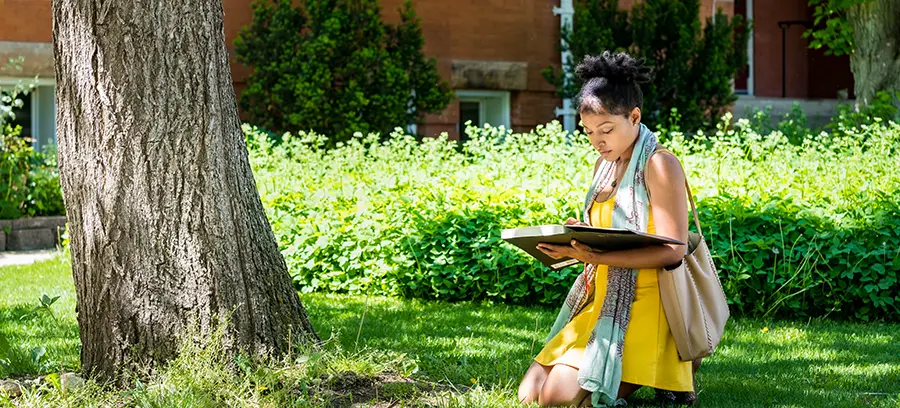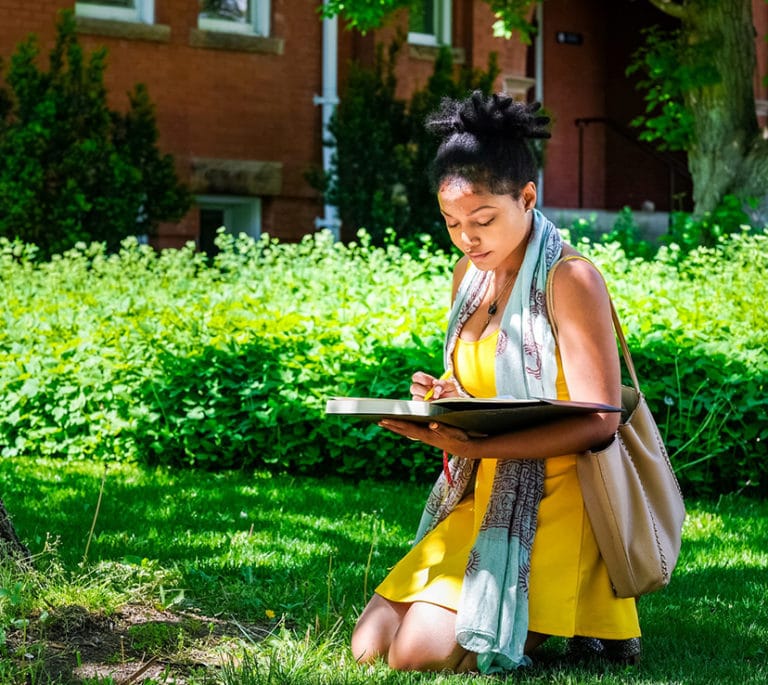Contemplative Drawing Practice: Drawing and Resting Outside
With Robert Spellman
Introduction
This practice draws sense perceptions into focus, heightening awareness of the present moment. The exercise asks us to coordinate our visual perception with the movement of the pencil on paper without the intervention of evaluation, critique or judgment. In this process, an intimacy between our eyes and the object being drawn arises naturally. This connection can be with an inanimate object, a landscape or a person, inviting a spontaneous sense of appreciation and even of beauty to emerge. “Drawing and Resting Outside” is a particular form of the practice which focuses on the contour line of landscape; our awareness thus extends to a larger sense of space and environment. This contemplative exercise cultivates mindfulness, presence, and empathy; and can be used in any classroom setting.Historical Background
This exercise is an elaboration and extension of the commonly taught “Blind Contour Drawing” developed by Kimon Nicolaïdes and used in many art schools since the 1930s. It has been further developed as a contemplative practice by Robert Spellman over the course of his teaching career at Naropa University.About Professor Robert Spellman
Robert taught in the Visual Arts, MFA Theater, and Religious Studies programs at Naropa University. He has worked as a painter, graphic designer, illustrator, piano re-builder, and musician. His work is exhibited nationally and internationally, and appears in numerous publications. Robert has practiced and taught Buddhist meditation for forty years. He was director of Dorje Khyung Dzong, a rural retreat center, and Karma Dzong, an urban meditation center in Boulder, Colorado. He is also co-founder of Mountain Water, an artist’s retreat in the wilds of southern Colorado. Visit his website at robertspellman.com.Benefits of this Practice
- Cultivates increased sensory awareness and mindful focus
- Invites a unique and intimate experience of “seeing”
- Frees and enlivens creative expression by removing evaluation
- Fosters a sense of connection with the objects being drawing as well as a broader awareness of space and environment
- Encourages curiosity and jump starts creativity
Preparations for Teaching
- Practice this exercise yourself and/or with a partner several times, journal and reflect on what you have gained from it, so that you can bring your personal experience to bear on the practice as you offer it in class.
- Reflect on where in your syllabus you want to situate the practice. Consider when students would most benefit from a creative mindfulness practice to broaden perspectives or break out of established patterns.
Steps for Teaching
- Create a conducive environment to introducing contemplative practice. Explain the reasons and benefits for contemplative practices in general and for this one in particular (see above for some of the benefits students have reported). It is important to note that there is no “right” way to do this practice and no “correct” experience; whatever the student notices will be helpful. This exercise is not about the final product, so invite students to practice being non-judgmental about their own work as well as that of their peers.
- We recommend letting the class know that there will be a discussion about the practice and that students will have a chance to discuss and share their experiences afterwards. This can help students go deeper into the practice.
- Give the instructions for the practice before going outside, so once outside there is minimal or no talking.
- Find a spot outside where you can be undisturbed for 15-20 minutes. Ask people to move in silence and to notice the transition from the classroom or art studio to being outside. Have everyone bring their sketch pad/paper and a pencil or pen.
- Have students find a comfortable seat (some may want to bring chairs or blanket), with a view of the surroundings. It may work best to sit in a half circle. Have their drawing materials within easy reach.
- Guide everyone in an opening mindfulness practice. You may use the following script: Find a nice comfortable seat where you can see the surroundings. Let your eyes be gently open. Allow all your senses – your seeing, hearing, feeling, and sense of smell – to be wide open and unobstructed. Just sit and let it all in, noticing what you notice in your senses. Sit without blocking whatever comes into your awareness and also without trying to hold onto anything in particular. Let your perceptions and sensations simply come and go. If you have a bell or gong, you can ring it and let everyone sit for 2-4 minutes.
- Drawing Practice Instructions: Have your drawing materials ready. Pick a point or an object, such as a tree, a power line, or a car. Put pen to paper and simultaneously allow your eyes to follow the outline of what you are looking at. As your eyes gaze one pointedly along the outline, let your hand trace the outline on your paper. Let your eyes and your drawing hand move together. You are just tracing the outline of what you are seeing. Your line could go from a tree, to a telephone pole, to a building, to a cloud; just keep drawing and following the outline with your eyes. Do not look down at your drawing; keep your eyes on the landscape and your pen on the paper. Do this for 3-4 minutes.
- Ring your gong or bell and have everyone put down their pencil and paper, without looking at their drawing. Resume mindful sitting and noticing sensory experience; sit for 3-4 minutes.
- Alternate between sitting in this way and tracing the outlines as described above, with 3-4 minutes for each. You may do this as many times as you wish; usually 2-3 times each works well. You can use the same piece of paper or multiple pieces for times of drawing.
Note: Seeing and tracing other people in one’s visual field can be part of this exercise as well.
- At the end, facilitate a discussion and give everyone a chance to discuss their experience and, if they wish, to share their drawings. This period of integration is important. Some questions to ask the class can include: How do you feel after this practice compared with before? What did you notice that felt new or different? What if any emotions came up during this exercise? What was most challenging? What felt easy? What feels valuable to remember from this experience?
Additional Teaching Notes
- As with many contemplative practices, we try to find the sweet spot between being true to the form and having a sense of naturalness and ease. Feel free to play with timing and language to best meet your students.
- Encourage students to really let themselves go and to not worry about what their drawings or tracings look like.
- The purpose of this exercise is not to satisfy anyone’s idea of a “good” drawing. The drawings done here are less important than the experience of being mindful and connecting hands to eyes without Judgment. If a student is doing the practice sincerely, they are doing it correctly.





